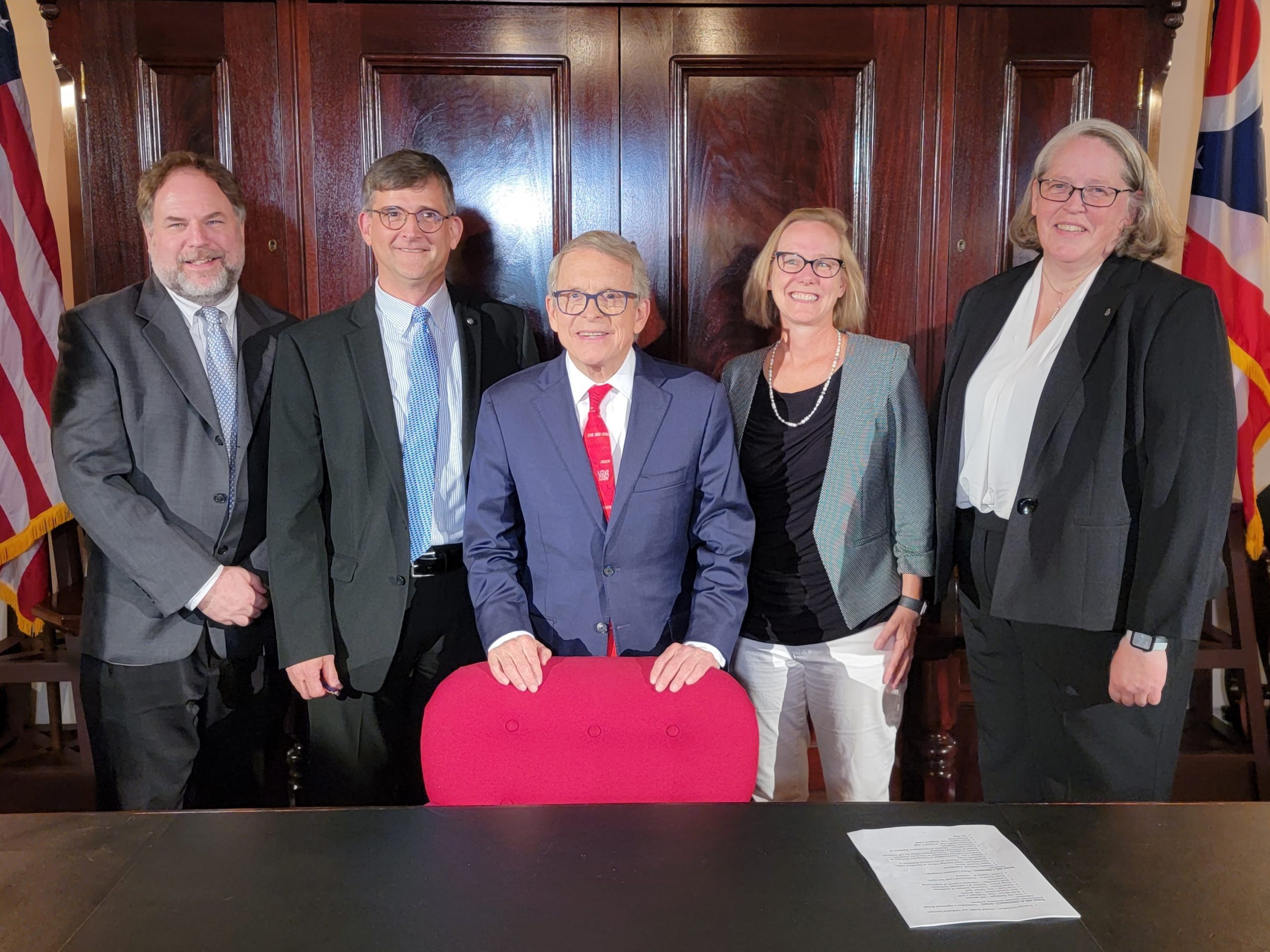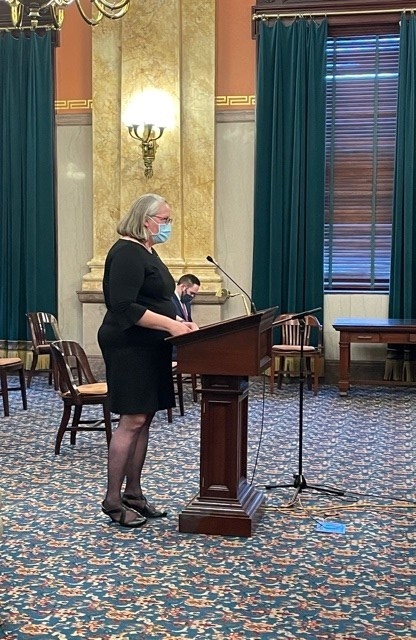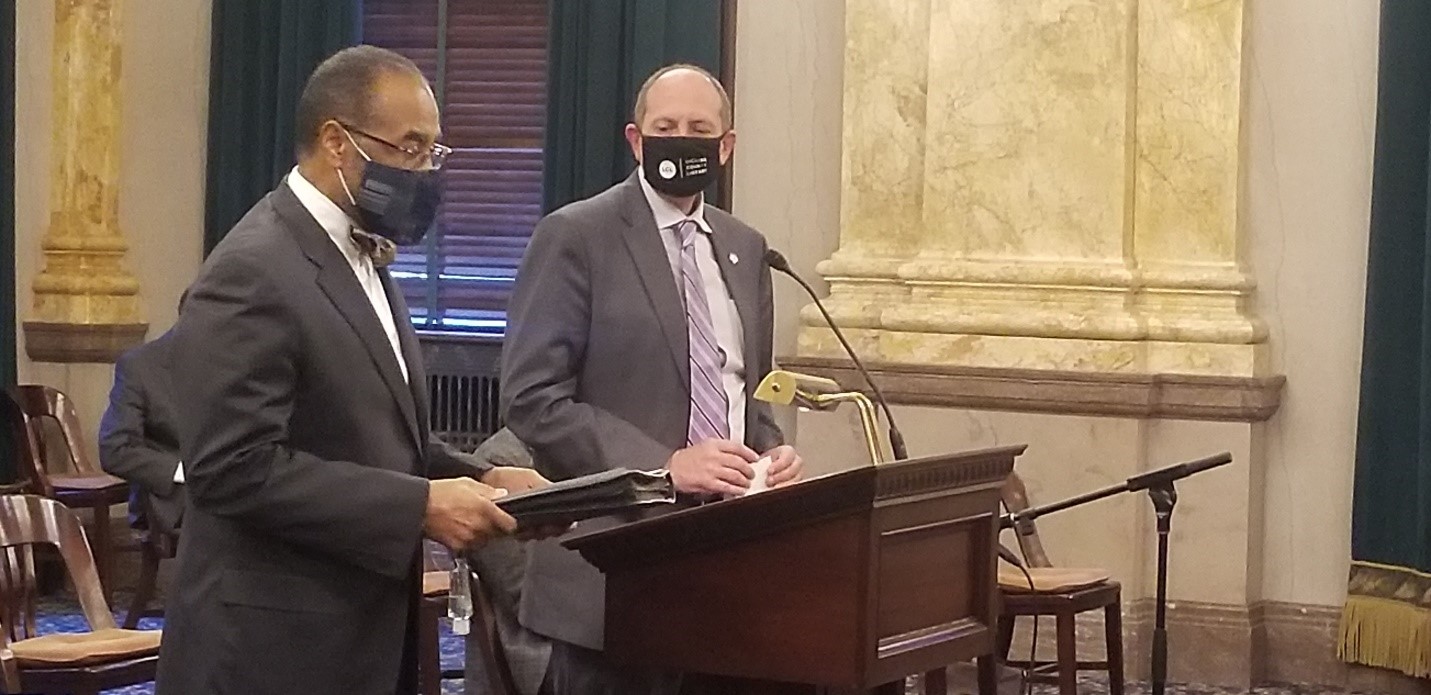Legislative Alert – Save Historic Preservation Tax Credits
Late last week a provision was added to HB96 (the budget bill) that would sunset Ohio’s Historic Preservation Tax Credit program in 2027. This bill is now being considered by the Conference Committee, a group of six legislators (three senators, three representatives), who are charged with working out the differences between the House-passed and Senate-passed versions of the legislation. Below are links to the listings for the six members of the Conference Committee. Please reach out to these legislators and ask them to remove this harmful language from HB96.
Rep. Brian Stewart (R-Ashville)
Rep. Mike Dovilla (R-Berea)
Rep. Bride Rose Sweeney (D-Westlake)
Sen. Jerry Cirino (R-Kirtland)
Sen. Brian Chavez (R-Marietta)
Sen. Paula Hicks-Hudson (D-Toledo)
The message is simple and can be conveyed via a phone call to their office or using the Contact form on their website: Historic preservation tax credits create jobs for Ohioans and generate investment in Ohio’s communities. Ending the program would devastate historic preservation efforts across the state. Since 2006, 448 projects across 68 communities in Ohio have been successfully completed. Cumulatively, these 448 projects have created:
• 638 Buildings rehabilitated
• 14,311 Housing units
• 32.9 million square feet rehabilitated
• $6.07 Billion Total project Investment
Legislative Alert – Ohio Special Election
AIA Ohio Member Advisory on SB56
Limitation of Liability for Ohio Design Professionals
A Legislative Update January, 2023
This document is for general information purposes and should not be regarded as legal advice. Readers should not act on information contained in this newsletter without seeking legal counsel.
RFP – Fire Station 1 Expansion | Marietta, Ohio
The City of Marietta, Ohio is seeking Statements of Qualifications from qualified Architectural and Engineering firms with respect to design services, bidding assistance, and construction administration for an expansion to Fire Station #1 located in Downtown Marietta. Click here for more details.
AIA Ohio’s Payment Assurance Legislation
SB 49, AIA Ohio’s Payment Assurance Legislation, was officially signed into law on July 1, 2021, in Governor DeWine’s office at the Ohio Statehouse. First introduced as SB136 in 2019, the bill took two legislative sessions and a lot of work by AIA Ohio’s Payment Assurance Committee together with lobbyist, Luther Liggett Jr., to make it to law.
AIA Ohio thanks Senators Jay Hottinger and Vernon Sykes for jointly sponsoring the bill. We are also thankful to our partners in promoting the importance of this issue, the Ohio Chapter of the American Society of Landscape Architects, the American Council of Engineering Companies of Ohio, and the Professional Land Surveyors of Ohio.
AIA Ohio has produced a document to instruct design professionals how to use this law to ensure payment for services provided. Click here to access these materials.

Pictured left to right: Chris Toddy, AIA, AIA Ohio Payment Assurance Committee Chair; Bruce Sekanick, FAIA, AIA Ohio Payment Assurance Committee; Governor Mike DeWine; Kate Brunswick, Hon. AIA, AIA Ohio Executive Vice President; Karen Planet, AIA, AIA Ohio President
April Legislative Update
Payment Assurance Legislation for Design Professionals
On Wednesday, March 31, 2021, the Senate Judiciary Committee invited Opponent Testimony on Senate Bill 49 at a third hearing, to create lien rights for Design Professionals. No opposition testimony was offered. We await a fourth hearing to vote the bill out of Committee, and onto the Senate Floor.
Organizations working with AIA Ohio in support of SB49 include:
- Ohio Chapter of the American Society of Landscape Architects (OCASLA)
- American Council of Engineering Companies (ACEC)
- Professional Land Surveyors of Ohio
Design Professionals in the construction industry have limited options when a commercial real estate owner does not pay for plans and specifications. Unlike construction contractors, the work of Architects, Landscape Architects, Engineers, and Surveyors does not improve the physical real estate, and therefore a Design Professional cannot file a mechanics’ lien. Ohio is the only state that offers no alternative payment protection.
The proposed Payment Assurance Program is modeled after the Brokers’ Lien codified in R.C. 1311.86 first effective in 2013. To avoid any conflict with the proposal, construction contractor mechanics’ liens always take precedence over a design professional’s lien, regardless of filing date. The Design Professional lien will apply only to commercial property, and not to residential property and not to public construction. The Design Professional lien will be subordinate to any real estate mortgage previously filed.
Indemnification for Design Professionals
Senator Louis Blessing III is sponsoring SB56, and AIA Ohio has sent a letter of support for the bill that would provide more equitable limits of indemnity clauses in design professional contracts for public improvements.
Passage of the bill would bring much needed relief to architects working on public improvement projects who are faced with the daunting risk of signing contracts that require architects to defend public entities against third-party claims before there is any determination that an error was committed by the architect providing the professional services.
Retired architects must carry “claims-made” malpractice insurance for the duration of the applicable statute of limitations.
Without passage of this bill, design professionals will continue to be asked to pay for and defend the public authority, its officers, and employees from third party claims that may be a result of issues well beyond the architect’s control and professional standard of care. The bill has been introduced by the sponsor to the Senate Judiciary Committee.
Regulatory Reduction Blocks Building Code
The Ohio Senate passed Senate Bill 9 on March 10, 2021, requiring removal of two regulations for every one enacted, thus blocking adoption of updated national model building codes. Introduced by Senator McColley (R, Napoleon) and Senator Roegner (R, Hudson), Senate Bill 9 now is assigned to the House Government Oversight Committee for three hearings.
Highly opposed by state agencies, on February 24th, representatives of the Ohio Building Officials Association and Fire Chiefs testified against the legislation.
As much of Ohio’s building and fire codes follow national or international codes for uniformity in materials and enforcement, editing the codes would have an unintended effect. The Ohio Building Officials Association is urging a legislative exception to the Ohio Board of Building Standards.
Contract Statute of Limitations Lowered
Ohio Governor Mike DeWine signed into law Senate Bill 13, to shorten the Statute of Limitations, requiring a person to allege a breach of contract claim in only 6 years, down from 8 years. Sponsored by Senator George Lang (R, West Chester), the new law is effective July 1, 2021.
Both chambers of the General Assembly passed the bill unanimously, bringing Ohio law into the mainstream of other states’ similar provisions.
This new law reduces exposure of lawsuits, of particular difficulty to retired design professionals who must carry claims-made liability insurance against personal malpractice claims during the statutory period.
The law does not impair the construction Statute of Repose barring any actions from even accruing after 10 years.
Transportation Funding
The General Assembly passed an amended Transportation Budget on March 25, 2021, sending the appropriation of $8 billion to the Governor for signature. House Bill 74 included a Senate amendment to increase the use of W-2 payroll workers employed by County Engineers. The Ohio Contractors Association opposed the increase in the “force account” threshold, as lessening available funding for independent construction contractors.
Unlike other legislation, the Governor enjoys a “line-item veto” power to delete appropriation items. It is not clear whether the Governor will delete any provision.
179d Tax Deduction Allocation Changes
The Ohio Senate concurred with House amendments in SB259 on December 22, 2020, approving language on the making the allocation of the 179d tax deductions simpler. Under the law established by SB259, a procedure is established which defines how the designer of a public building may request the allocation of a federal income tax deduction for designing energy efficient building systems in Ohio.
This new procedure, which takes effect on April 12th, requires public entities to grant allocations within 15 days of the request by qualified designers. The process also prohibits state or local entities, or its employees, from seeking fees, payment of other considerations for allocations deductions. This new language addresses long standing concerns of design professionals who have been required to provide additional services or fee reductions to be given the opportunity for the tax deduction allocation.
SB49 Receives Second Hearing – Mar. 2, 2021

Proponent testimony for SB49 (Payment Assurance Legislation) was presented on March 2 by AIA Ohio President Karen Planet, AIA and Bruce Sekanick, FAIA.
Planet said the bill will establish “a much-needed payment assurance program for design professionals including architects, landscape architects, engineers, and surveyors.”
“Design professionals currently have limited options when a commercial property owner does not pay for plans or specifications,” she said. “It is inequitable when an owner goes forward with construction without compensating architects for their design work. Unlike construction contractors, the work of design professional does not improve the physical real estate, and therefore a design professional cannot file a mechanics’ lien. Ohio is the only state that offers no alternative payment projection for design professionals.”
Sekanick, who owns an architectural firm in Warren, said the bill provides architects and construction industry design professionals with an important tool to ensure payment for professional services. Upon questioning, he told Sen. Antani that there are variations of the provisions in the bill all 49 other states.
Additional written proponent testimony was submitted by Paula Hammer of the Professional Land Surveyors of Ohio; Beth Easterday on behalf of ACEC-Ohio and Doug Boyer on behalf of the Ohio Chapter of the American Society of Landscape Architects.
AIA Ohio Payment Assurance Legislation Receives Hearing – Feb. 23, 2021

Senators Vernon Sykes (left) and Jay Hottinger offer sponsor testimony for SB49 to the Senate Judiciary Committee
Senate Bill 49, AIA Ohio’s Payment Assurance Legislation (PAL), received its first hearing by the Senate Judiciary Committee on Feb. 23. The bill’s joint sponsors Sen. Vernon Sykes (D, Akron) and Sen. Jay Hottinger (R, Newark) testified that the bill would create a design professional lien right modeled after the brokers’ lien.
If passed, this legislation would establish a payment assurance program for registered design professionals. The design professional lien will:
- Apply only to commercial property, and not to residential property;
- Apply only to private work, and not to public construction; and
- Will be subordinate to any real estate mortgage previously filed.
A proponent hearing has yet to be scheduled. Click here to read the full testimony of Senators Sykes and Hottinger.
AIA Ohio Annual Meeting – Friday, Nov. 13, 2020, 3 p.m.
Important Notice for K-12 from BBS
![]() The Board of Building Standards has updated its BBS Memo regarding the moratorium for storm shelters in Group E occupancies to include the following:
The Board of Building Standards has updated its BBS Memo regarding the moratorium for storm shelters in Group E occupancies to include the following:
September 2020 Update: HB 164 adopted by the Ohio General Assembly on June 11, 2020, amended R.C. 3781.1010 to extend the storm shelter moratorium to November 30, 2022.
The updated Memo can be found here.
If you have questions related to information contained in the Memo, please contact the Board’s technical staff at 614-644-2613 or at bbs@com.state.oh.us.
AIA Responds to Trump Administration Rollback of Fair Housing Policy
HUD rollback of Fair Housing policy puts communities at risk
Housing inequities in American communities will be exacerbated by dismantled rule.
WASHINGTON – July 29, 2020 – The American Institute of Architects (AIA) condemns the recently announced rollback of the Affirmatively Furthering Fair Housing (AFFH) provision (2015) of the 1968 Fair Housing Act.
Under the Affirmatively Furthering Fair Housing (AFFH) rule, communities receiving federal subsidies were required to analyze racial segregation in housing and then submit plans to reverse such trends. The AFFH rule had been weakened in recent years. In 2018, the Department of Housing and Urban Development (HUD) eliminated the Local Government Assessment Tool, which was designed to help local governments combat racial segregation in subsidized housing. However, the Administration’s latest actions have officially nullified the original AFFH rule and its intent.
“AIA strongly opposes the Administration’s dismantling of this critical rule,” said AIA EVP/Chief Executive Officer Robert Ivy, FAIA. “Our federal government should confront the legacy of discriminatory housing policies as intended in the Fair Housing Act of 1968, not shrink away from the responsibility of ensuring our communities are equitable. At such a critical moment in time for addressing racial inequity, it’s clear we need to do more, not less, to provide equitable opportunity to all Americans, especially for a basic human need such as shelter.”
AIA has had a longstanding commitment to equitable communities, including advocating for affordable housing initiatives. On Jan. 24, AIA 2020 President Jane Frederick, FAIA, and AIA 2019 President Bill Bates, FAIA, met with the HUD assistant secretary for policy development and research to share AIA’s affordable housing priorities. Additionally, AIA provided comment on Jan. 31—following a request from HUD leadership—regarding the Administration’s call to eliminate regulatory barriers to affordable housing.
Learn more about AIA’s advocacy efforts online.
Click here to view original post.
Ohio 133rd General Assembly Legislative Update
Click here to view the status of current General Assembly bills related to the practice of architecture.
